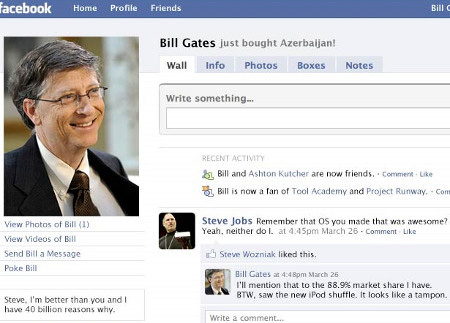
Irving Goffman lived a long time ago
| I decided to do a discourse analysis looking at Facebook profile pictures and comments on the pictures to find patterns and how identity is discussed. I chose to do a discourse analysis because it emphasizes the importance of intertextuality, which proposes that meaning is found not by studying only one text and image, but by comparing that texts and images with others (Rose 142). In order to answer my question, I had to step outside of my own experience and really look around at other pictures and see what is going on out there. As I embarked this research, I recognized that this research is closely tied to identity, because the picture represents the identity of a person. | |
| Let's face it, Facebook itself is a discourse strongly tied to
making identities by the simply fact that it revolves around "profiles"
of self and others. Visual communication is an integral part of this
process. The profile picture is not just a nice addition, is arguably
the most predominant feature of a person's activity on Facebook. A
person's home page start with a profile picture, considerably larger
than any other postings on the page, and is followed by the name to the
right in much smaller space. It can become clear from this instance
alone that the picture carries more weight than the name does on
Facebook. Also, because the picture is on the far left and we as a
culture read from left to right, it can be assumed that, after the words
Facebook, we will see the picture first. It is also considerably larger
than the title Facebook, which is above the name, so it is arguably more
attractive than even the logo of the site itself. We can see from this
argument alone how important this profile pictures are.
|  |
|
This pattern of emphasis on the picture carries
into other facets of Facebook, including any interaction with friends.
When friends look at friends, their profiles are the exact format as
their own. They see a large picture on the top left, and see their
name, much smaller, following. As can be seen in the picture above. This is a picture of a fake Facebook website created by www.geekologie.com.
This trend continues off the profile
pages. Most activity on Facebook (excluding browsing, stalking, and, of
course, and some of the games) is documented through posts on walls,
where people post on their own site or their friends', and/or the home
page, which shows activity of any of your friends on Facebook. Both of
these locations are filled with postings such as comments, which are
created in friend’s sites a message in box beneath their name that says
"write something." In this same box, a person can make their own status,
or something they want to say that will be read by any of their friends,
in the same bar. Other postings include posting creating a new album,
uploading pictures, uploading a video, writing a note, and joining
interest groups/event groups. The importance of explaining that is that
each posting starts with a thumbnail profile picture of the person who
posts and continues with their name and whatever they are posting. This
is true when a person posts on their own wall and on other’s walls, or
even when they add comments to posts on the home page. Any activity is
accompanied by their profile picture and name, followed by the specific
activity. You can see the process emerging: visually gather a profile,
connect it to the name and then the other information. Whatever posting
follows the profile to "tell you about a person" is immediately not as
important as the picture itself, because the picture initiates the
posting. Of course they eye may skip over the picture if the post
catches their eye first, but that doesn’t change the fact that it starts
with the visual representation of who this person is. The identity of a
user and how they are connected with other users starts off with an
image. Through these examples, we see that the construction of image is
heavily emphasized through the visual presentation of the self.
According to many contemporary social theorists, a person attempts
to control or guide the impression others might have of him or her by
fixing his or her setting, appearance and manner to achieve what is
culturally considered ideal (Goffman 35). In this line of reasoning,
people have the ability to decide what is appropriate for a situation
and act accordingly. Applying this concept to Facebook profile pictures,
we see that people learn what pictures are appropriate through
interaction with society, specifically with peers and other social
influences. I would argue that these trends show a blend of society and
the user's personal life because they are situated within a discourse
that is influenced by other users and media flow (such as
advertisements, celebrities). Whether users are aware or not, they learn
how to appropriately act and behave on Facebook, through observation and
conscious or unconscious application (Goffman; Schechner). We can see
how this theory applies to Facebook even more clearly through Mark
Poster's work. He writes that that on "the internet, individuals
construct their identities in relation to ongoing dialogues, not as acts
of pure consciousness"(211). He would likely argue that Facebook users
construct their identities in relation to the pictures they display on
Facebook. However, it does not happen consciously or as a direct
reciprocation between the picture and the user. Rather, it is a method
of complex interactions between consumer, producer and the greater
social setting in which it is located.
This analysis shows what pictures are considered
appropriate by looking at the commonalities between the pictures and
looking at the ways that people comment on the pictures. It assumes that
the pictures with the most comments are seen as being "more appropriate"
and the pictures with fewer comments are seen as being "less
appropriate." Appropriate indicates that it successfully fits within the
norms of the discourse, not a moral "appropriate." In doing this, it
will show through the image and the comment what the users value and
appreciate from the pictures. It will finally show that that the values
found can be linked to values in popular culture, especially as the
values are linked to visual qualities within the picture. Whether users
choose to accommodate with or resist the ideologies of this particular
culture, it doesn't change the fact that their pictures quickly become
assimilated as a part of the new aspect of popular culture. They are
embedded within a stream of media flow, which has specific implications
about the way that pictures are consumed. Through the analysis, I will
show that user's profile pictures show that Facebook is situated within
a discourse of popular culture.
|
|